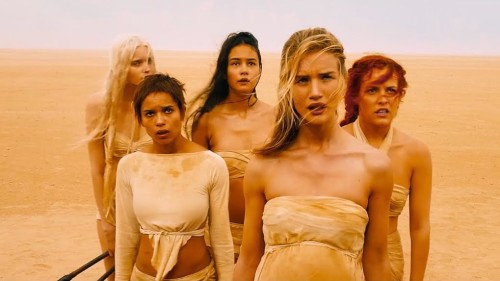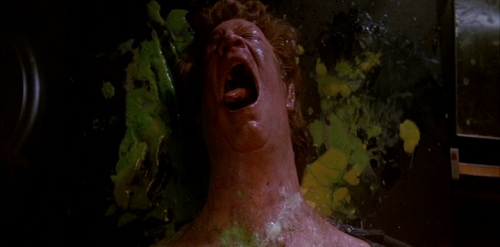This guest post by Gabrielle Amato appears as part of our theme week on Dystopias.
Often, dystopia is about exposing where we’re going wrong and giving us a reason to course correct by showing us the worst case scenario of consequences. Human folly is a common undertone in dystopian fiction, especially sci-fi and horror, showing us an exaggerated form of the suffering we will have to endure if we cannot change. In Battle Royale, we see a world where the criminalization of youth has lead a society to fear its own children so much that middle-schoolers are forced to murder each other. In I Am Legend, a proud doctor informs the world that she has cured cancer using an engineered virus, but her hubris is our downfall. The virus kills 90 percent of the population and turns the other 10 percent into ravenous zombies. In Fahrenheit 451, rampant anti-intellectualism produces a world where books are illegal.
Mad Max: Fury Road is less about illustrating for us what consequences await if we don’t change our ways and more about what we must do once those consequences befall us. It’s about whether or not society can, as Furiosa hopes, be redeemed. Fury Road shows us a quick sketch of our situation: the world is a barren, wind-blasted desert; Immortan Joe controls the water and the people, using women to breed and feed an army of War Boys who maintain his grip on The Citadel by sacrificing their lives in battle. The driving plot of the movie is Furiosa and The Wives looking for a way out of this oppressive dystopia.
Although Fury Road does not show us how we arrived here, it does a very good job of identifying exactly who and what is wrong with society. Women are livestock, used for breeding and milking to maintain Immortan Joe’s army. With the exception of Furiosa and her honorable position as the driver of a massive war rig, the only place we see women in The Citadel is within Immortan Joe’s chambers, imprisoned there for his use. In the chase through the desert, The People Eater frequently refers to The Wives as “assets” to be protected.

And, although The Citadel is ruled by powerful men with disabilities, we understand it to be a fundamentally ableist society. Immortan Joe is questing for a “perfect” son and has clearly chosen The Wives for their beautiful, unblemished, able bodies in an attempt to breed one. We understand that this is a patriarchy in its most extreme form where women have no personhood at all.
When The Wives flee their chambers, they leave behind two explicit messages: “we are not things” and “our babies will not be warlords.” Immortan Joe’s patriarchy doesn’t only objectify and exploit women. Though only older boys are sent riding to war we see many War Pups, boys who haven’t reached puberty yet, some barely more than toddlers, in The Citadel.

Though these War Pups are too small to drive and fight their faces are still painted like skulls, their little bodies pressed into the service of Immortan Joe. In The Citadel little boys do not enjoy a childhood. They have no experience and therefore no concept of compassion or kindness or human connection. The moment they are useful they are put to work and, more importantly, begin receiving the brainwashing that will eventually render them into fanatical War Boys willing to die at the whim of their leader. Women are livestock and boys are weapons.
It doesn’t matter how the world got this way, but it does matter who made it this way because those people are still in power. Who Killed The World? The implication is clear; it was the patriarchy. It was men like Immortan Joe, The People Eater, and The Bullet Farmer who even now continue the same destructive habits. Resources are tightly controlled by these men to satisfy their greed, and only doled out to others if it will serve the masters. Immortan Joe goes so far as to stage the ceremonial release of water down onto The Wretched just to display and revel in his own boundless power.

It’s a surprisingly explicit reference to the connection between power and abuse: Immortan Joe positions himself as a savior figure while at the same time turning the blame for the suffering of The Wretched back onto their own “addiction” to water. The systematic oppression of The Citadel is denied.
So what can Furiosa and The Wives do under these circumstances? Their first strategy is one most of us would choose. If the place where you live is terrible, you leave it behind. You try to find a new place, a green place. But escaping isn’t so easy. When Furiosa’s war rig breaks down and the fugitives realize that they are being pursued, Cheedo has a crisis of courage. She runs off across the sand toward the coming army, insisting, “We were his treasures. We were protected. He gave us a life of luxury, what’s wrong with that?” Cheedo has learned to survive as an object, and still believes that the best possible life she can hope for is one with the meager privileges of being chosen as the treasure of a powerful man. Although they are far from The Citadel, Cheedo has not left it yet. But it isn’t only Cheedo’s internalized oppression that conspires against these women. When Furiosa at last brings her companions to a place she remembers, the remaining Vuvalini they meet tell her that The Green Place is now barren. Even that piece of earth has gone sour like all the rest. Now there are only two choices left: keep running and hope to stumble across an oasis or return to the only place they know to be capable of sustaining human life.
They cannot escape this dystopia and find a utopia; the former must be refashioned into the latter. Mad Max: Fury Road shows such a remaking of the world is possible by first showing such a remaking of people. When Capable discovers Nux stowed away on the war rig she treats him like a person. She is kind to him and when she touches him she does so with tenderness. This is the first time that Nux has experienced human interaction that isn’t based in violence, as far as we can tell. Early in the film we see that his relationship with other War Boys is based on masculine posturing and competition. In a moment when he is vulnerable, lost, and humiliated Capable meets him with compassion and empathy, and we see how quickly it changes him. Having his humanity validated immediately turns Nux’s loyalties – he doesn’t want to be a thing anymore.
When Cheedo reaches for Rictus Erectus from the hood of the war rig we wonder if she has given up hope once and for all. But instead she uses her own fragility as a trick, and we understand that she has changed too.

Even Cheedo, so fearful that she wanted to turn back, has decided that it is better to risk everything for the chance to be a person than to return to being a treasure. She doesn’t want to be a thing anymore either. It is through the transformations in Cheedo and Nux that we see how Furiosa, the Vuvalini, and The Wives will transform the entire Citadel.

At first, The Wives leave with Furiosa because, as she tells Max, they are looking for hope. But Max knows that hope is a mistake; you have to fix what’s broken. It’s Furiosa’s desire for redemption the reveals the right path. The fact is, it is too late to avert disaster. We are already living in an oppressive patriarchy that treats women like breeding stock and men like weapons, and our environment has already been drastically altered by global warming. But there is no green place we can escape to. We cannot leave society and we cannot leave the planet; this is what we’ve got to work with. Further, even if we could run away to some hidden oasis to form our utopian feminist society, who would we leaving behind? Is it right to abandon the War Pups, the Milking Mothers, and The Wretched to save ourselves? Mad Max: Fury Road teaches us that the only way out of the dystopia is through it. You must choose to remake it, and yourself, into something better.
Gabrielle Amato received her BA in Liberal Arts from Sarah Lawrence College where she focused on women’s studies. Currently she works in violence prevention, and in her spare time attempts to write useful and interesting articles about feminism, pop culture, and rape culture.









